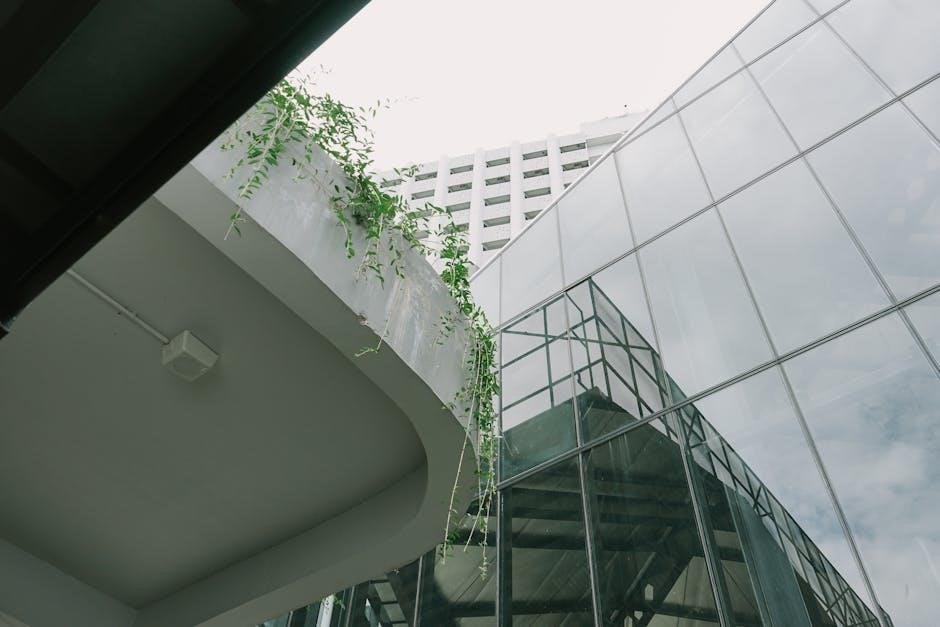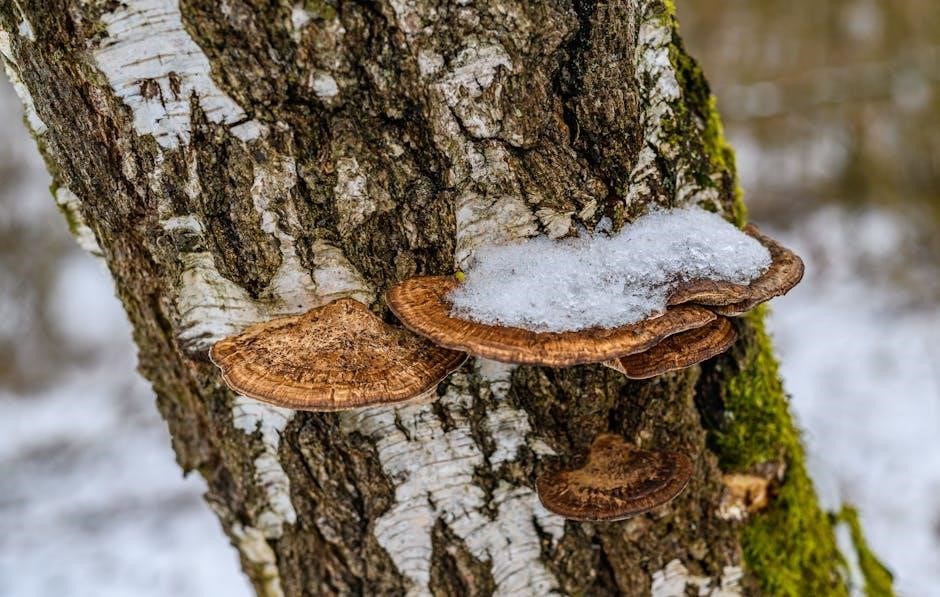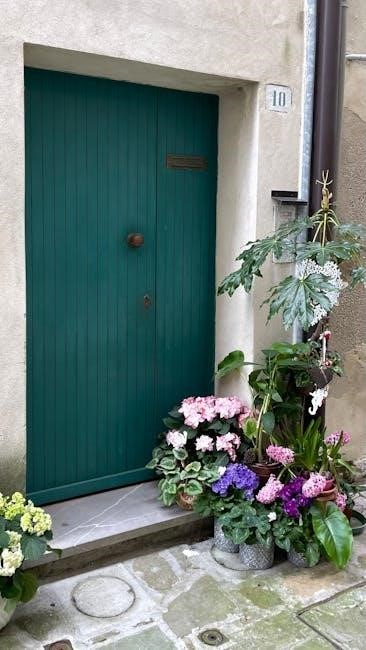Zone 10 offers a unique gardening experience with its warm, frost-free climate and year-round growing opportunities; This guide helps gardeners maximize their planting potential, covering optimal times, plant selection, and seasonal strategies to thrive in this subtropical environment.
Overview of USDA Plant Hardiness Zone 10
USDA Plant Hardiness Zone 10 is characterized by its warm, subtropical climate with mild winters and long, hot summers. The average minimum winter temperatures range from 30°F to 40°F, with frost being rare or nonexistent in most areas. This zone offers over 300 frost-free days annually, making it ideal for year-round gardening. Zone 10 encompasses regions like parts of California, Florida, and Texas, where gardeners can grow a wide variety of tropical and subtropical plants. The extended growing season allows for multiple harvests of vegetables, fruits, and flowers, making it a paradise for gardeners. Understanding Zone 10’s unique conditions is key to maximizing its gardening potential.
Key Characteristics of Zone 10 Climate
Zone 10’s climate is subtropical, featuring mild winters and hot, humid summers. With over 300 frost-free days annually, the growing season is nearly year-round. Winter temperatures rarely drop below 30°F, while summer heat often exceeds 90°F. Coastal areas tend to be cooler, while inland regions experience higher temperatures. The zone’s climate supports tropical and subtropical plants, making it ideal for diverse gardening. High humidity and abundant sunlight are common, though water management is crucial during dry spells. These conditions create a unique environment where gardeners can enjoy multiple harvests and a wide variety of plant species throughout the year.
Importance of a Planting Guide for Zone 10
A planting guide is essential for Zone 10 gardeners to optimize growth and yield. Despite the long growing season, understanding optimal planting times ensures plants thrive in the region’s warm, humid climate. By following a guide, gardeners can avoid planting during extreme heat, manage water efficiently, and prevent pest issues. It helps in selecting suitable plants for each season, maximizing space, and planning for continuous harvests. A guide also aids in adapting to local microclimates and addressing common challenges, making gardening more successful and enjoyable. Whether growing vegetables, fruits, or flowers, a tailored planting guide is key to achieving a productive and vibrant garden in Zone 10’s unique conditions.

Best Plants for Zone 10
Zone 10 supports a wide variety of plants, including tropical fruits like mangoes and avocados, vegetables such as tomatoes and peppers, and vibrant flowers like hibiscus.
Vegetables That Thrive in Zone 10
Zone 10’s warm climate allows for a wide variety of vegetables to grow year-round. Popular choices include tomatoes, peppers, eggplants, and okra, which love the heat. Cool-season crops like spinach, kale, and carrots thrive in Zone 10’s mild winters, while summer squash, zucchini, and cucumbers excel in its long growing season. Root vegetables such as beets and radishes also grow well. Succession planting is key due to the extended growing season, enabling multiple harvests. Proper soil preparation and consistent watering are essential for optimal growth. With the right techniques, Zone 10 gardeners can enjoy a bountiful harvest of fresh vegetables throughout the year.
Fruits and Trees Suitable for Zone 10
Zone 10’s subtropical climate is ideal for growing a wide variety of fruits and trees. Tropical fruits like mangoes, papayas, and guavas thrive in the region’s high humidity and heat. Citrus trees, such as oranges, lemons, and limes, are also highly successful. Avocado trees, banana plants, and passionfruit vines are popular choices due to their adaptability. These plants typically require well-draining soil and full sun to flourish. The long growing season in Zone 10 allows for multiple harvests and the ability to grow exotic species that wouldn’t survive in cooler zones. Proper care, including regular watering and mulching, ensures healthy growth and abundant fruit production.
Flowers and Ornamental Plants for Zone 10
Zone 10’s warm, frost-free climate is perfect for vibrant flowers and ornamental plants. Hibiscus, bougainvillea, and lantana thrive in the region’s heat, offering colorful blooms year-round. Birds of paradise and heliconias add a tropical touch, while succulents like aloe and agave flourish in dry conditions. Desert roses and plumeria are also popular for their beauty and fragrance. These plants typically require full sun and well-draining soil to perform best. Zone 10 gardeners can enjoy a wide variety of low-maintenance, drought-tolerant options that bring life and vibrancy to landscapes. The long growing season allows for continuous blooms, making it ideal for creating stunning floral displays and attracting pollinators.

Seasonal Planting Guide
Zone 10’s long growing season allows year-round planting opportunities. Adapt strategies to seasonal temperature shifts, ensuring optimal growth and harvest success throughout spring, summer, fall, and winter.
Spring Planting in Zone 10
Spring planting in Zone 10 begins early, as frost danger typically ends by late January. This period is ideal for cool-season vegetables like broccoli, spinach, and carrots. Gardeners can also start seeds for warm-season crops such as tomatoes and peppers indoors before transitioning them outside. Flowers like marigolds and zinnias thrive in spring’s mild temperatures. Soil preparation is key, with compost additions to enhance fertility. Proper watering and sunlight exposure ensure healthy growth. Succession planting allows multiple harvests, making spring a vibrant and productive season for Zone 10 gardeners.
Summer Planting in Zone 10
Summer in Zone 10 is ideal for heat-loving plants, with warm temperatures and long days. Vegetables like tomatoes, peppers, eggplants, and okra thrive during this season. Fruits such as mangoes, papayas, and citrus trees also excel in the summer heat. Florals like hibiscus, lantana, and bougainvillea add vibrant colors to gardens. Soil preparation is crucial, requiring organic matter to retain moisture and nutrients. Regular watering is essential, but overwatering should be avoided to prevent root rot. Mulching helps retain soil moisture and suppress weeds. Pest control is vital, as summer heat attracts insects like aphids and whiteflies. With proper care, summer planting in Zone 10 can yield abundant and diverse harvests.
Fall Planting in Zone 10
Fall in Zone 10 is an excellent time to plant cool-season crops, as the weather cools slightly, reducing the intense summer heat. Vegetables like broccoli, spinach, kale, and carrots thrive during this season. Fruit trees such as strawberries and blueberries also benefit from fall planting. Soil preparation is key, with the addition of compost to enrich the ground. Consistent watering is necessary, but overwatering should be avoided. Mulching around plants helps retain moisture and regulate soil temperature. Fall planting in Zone 10 allows gardeners to take advantage of the cooler evenings while still enjoying a long growing season. This period is ideal for succession planting, enabling multiple harvests before winter arrives.
Winter Planting in Zone 10
Winter in Zone 10 is mild, offering a unique opportunity to grow a variety of plants. Cool-season vegetables like lettuce, radishes, and peas thrive in the cooler months. Citrus trees, such as lemons and oranges, can also be planted during this time. Soil preparation remains crucial, with regular mulching to retain moisture and protect roots; Watering should be moderate, as the lower humidity reduces water loss. Winter planting in Zone 10 allows gardeners to enjoy fresh produce year-round, taking advantage of the region’s subtropical climate. This season is also ideal for planting bulbs and perennials, ensuring vibrant blooms in the following spring. With proper care, winter gardens in Zone 10 can be highly productive and rewarding.

Gardening Tips and Tricks for Zone 10
Zone 10’s warm weather allows year-round gardening. Use organic soil amendments, water deeply but infrequently, and monitor for pests. Mulch retains moisture and regulates soil temperature.
Soil Preparation and Care
Preparing the soil is essential for a thriving garden in Zone 10. Test your soil pH and adjust it based on plant requirements. Incorporate organic matter like compost or well-rotted manure to improve soil structure and fertility. Mulch regularly to retain moisture, suppress weeds, and regulate soil temperature. Avoid over-tilling, as it can damage soil microbes. For containers, use high-quality potting mix with good drainage. Rotate crops to prevent nutrient depletion and pests. Add worm castings or balanced fertilizers during planting for an extra nutrient boost. Proper soil care ensures healthy root development and maximizes plant growth in Zone 10’s warm climate.
Watering and Irrigation Strategies
Watering is critical in Zone 10’s warm climate. Plants typically need consistent moisture, especially during hot summer months. Use drip irrigation or soaker hoses to deliver water directly to roots, minimizing evaporation. Avoid overhead watering to reduce fungal diseases. Water deeply but infrequently to encourage deep root growth. Mulch around plants to retain soil moisture. For containers, ensure good drainage to prevent root rot. Monitor soil moisture by checking the top few inches daily. Adjust watering schedules during cooler months to prevent overwatering. Proper irrigation management ensures healthy plant growth and resilience against drought in Zone 10’s subtropical conditions.
Pest Control and Common Challenges
Zone 10’s warm, humid climate attracts pests like aphids, whiteflies, and spider mites. Regularly inspect plants and use neem oil or insecticidal soap for control. Encourage beneficial insects like ladybugs and lacewings. Root rot and fungal diseases thrive in moist conditions, so ensure proper drainage and air circulation. Snails and slugs are common; trap them with beer or copper barriers. Weed regularly to prevent competition and pest habitats. Balanced fertilization avoids over-fertilizing, which can attract pests. Monitor for nutrient deficiencies and address them promptly. Practice crop rotation to break pest life cycles. Use organic methods first to avoid harming beneficial organisms. Stay vigilant, as Zone 10’s year-round growth means constant vigilance against pests and diseases;

Tools and Resources for Zone 10 Gardeners
Essential tools include gardening gloves, irrigation systems, and soil testers. Resources like planting calendars, gardening apps, and local nurseries provide valuable guidance and materials for Zone 10 gardeners.
Planting Calendar and Apps
A reliable planting calendar tailored to Zone 10 is essential for optimizing growth and harvests. Digital apps like Garden Plan Pro and Gardening Know How offer personalized planting schedules based on your specific climate and frost dates. These tools provide reminders for planting times, space optimization, and weather alerts, ensuring you never miss the ideal window for sowing seeds or transplanting. Additionally, apps often include databases of Zone 10-friendly plants, complete with care tips and success strategies. By leveraging these resources, gardeners can streamline their planning process and maximize productivity throughout the year.
Local Nurseries and Gardening Communities
Local nurseries and gardening communities are invaluable resources for Zone 10 gardeners. These establishments often specialize in plants suited to the region’s subtropical climate, offering expert advice and locally grown species. Joining gardening groups or online forums connects you with experienced growers who share tips, tricks, and recommendations tailored to Zone 10. Many communities host workshops, plant swaps, and seasonal events, fostering collaboration and knowledge exchange. By engaging with these networks, gardeners can gain insights into the best practices, troubleshoot challenges, and discover new planting ideas specific to their area, enhancing their overall gardening success and enjoyment.



